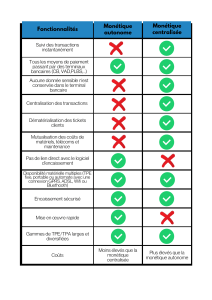Comparison between autonomous and centralised monetic systems
Check out our comparison table between stand-alone and centralised monetic systems to help you choose the solution best suited to your needs.
The differences between autonomous and centralised monetic systems
First of all, stand-alone monetic solutions operate locally. In other words, when a transaction is carried out, it does not appear directly in the merchant’s bank account. Transactions are first stored on the payment terminal, usually for one day. They are then sent to the bank in batches via remote collection. This is usually scheduled at night and enables the money to arrive at the bank servers.
Centralised electronic payment systems allow organised retailers to bring together all their shops’ electronic payment flows on a single secure electronic payment server. This server offers its administrator instant monitoring of transactions. This back office integrates all the payment methods used by bank terminals such as CB, VAD, AMERICAN EXPRESS, CUP, PLBS, etc. Transactions are sent in real time to the server, which consolidates all the transactions and makes a single night-time remote collection for all the Eftpos terminals.
To find out more about centralised monetic.
The different manufacturers
To date, electronic payment manufacturers Ingenico and Verifone have developed both operating systems. In fact, their complete ranges of Eftpos terminals can be used for both centralised and stand-alone monetic. Ingenico’s centralised electronic payment system is called AXIS, while Verifone’s is PAYware Wynid.
Other manufacturers are coming up with centralised solutions, such as PAX with its NEPTING solution.
Table comparing the functionality of the two solutions
